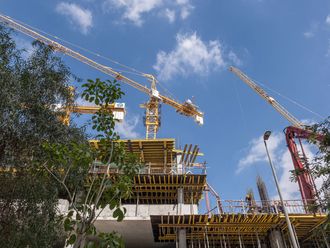Mumbai: Shares in India posted their best performance in three years, and bulls have their tails up for the new year in anticipation of stronger earnings outlook in an economy that is expected to topple the United Kingdom and France to become the world’s fifth largest in 2018. On the surface, the building blocks for faster growth seem to be in place, but risks also linger that could make the ride rocky.
Earnings of the 50 companies that make up the benchmark Nifty index are expected to climb 13 per cent in the December quarter, according to Bloomberg, after they grew 14 per cent in July-September, the first double-digit expansion in 13 quarters. The growth is forecast to pick up steam in 2018.
GDP growth, which rebounded to 6.3 per cent in the three months ended September from a sharp slowdown to 5.7 per cent in the June quarter, is projected to accelerate to well above seven per cent in the financial year 2018-19 that begins next April. The string of reforms initiated by New Delhi, specifically the Goods and Services Tax (GST), a bankruptcy law that enables lenders to recoup debts from defaulters and measures to scrap bureaucratic red-tape, should make it easier to do business.
“There is optimism at the cusp of the new year,” said equity strategist V. Venugopal. “Growth is back on track and the fruits of reforms are bound to provide thrust.”
After a record-setting run the market value of all stocks listed on the BSE, Asia’s oldest bourse, soared to $2.3 trillion (Dh8.4 trillion) at the close of 2017, equivalent to the country’s GDP. Equity benchmarks beat forecasts by a wide margin, providing investors bountiful gains in a year that began under a cloud of deepening worries.
“Ironically, at this time a year ago, scepticism was the watchword all around after the biggest currency upheaval in memory,” Venugopal said. “The gamble proved a bonanza for stock markets as household savings moved into equity assets.”
He was referring to Prime Minister Narendra Modi’s abrupt decision on November 8, 2016 to remove high-value bank notes that comprised 86 per cent of the currency in circulation. The demonetisation, ostensibly to flush out unaccounted cash hordes, caused immense hardships to the middle class and the poor and wrecked economic activity.
Storm weathered
As the curtain comes down on 2017, there is relief the shakedown is worn out. The economy is brimming again and there is hope of better days ahead. The trajectory of stock markets, which discounts future events, is a good indicator.
The top-30 Sensex closed at 34,056.83, soaring 27.9 per cent in the year, after hitting an all-time high of 34,137.97 on Wednesday. It was the biggest annual percentage gain since 2014, when the widely tracked benchmark leapt almost 30 per cent powered by the Modi-led Bharatiya Janata Party’s landslide victory in general elections and hopes for economic revival.
The 50-share Nifty, which is often mimicked by portfolio managers, rose 28.7 per cent in 2017 to 10,530.70, just off the intraday record of 10,552.40 reached on Wednesday.
The combined wealth of equity investors grew by $711 billion in 2017. Gains in the broader market and other segments were higher, suggesting deep-rooted confidence among investors about the outlook for companies. The demonetisation drove all cash into the vaults of banks, and brought down borrowing costs as inflation dipped to the lowest in decades.
The clampdown on unaccounted wealth dented traditional investment avenues such as property and gold, and caused a shift in preference for financial assets. Inflows into domestic equity mutual funds soared to about $18 billion, making them the main force behind the stocks rally that left seasoned foreign funds in catch-up mode.
The BSE-500 index jumped almost 36 per cent in 2017, while the BSE MidSmall cap index rocketed 54.6 per cent. The BSE-All Cap rose 36.7 per cent and BSE Auto climbed 32.1 per cent.
Private equity inflows surged to a record $24.4 billion, led by information technology and allied services that took in $11.4 billion and followed by financial services at $4.4 billion.
Turnaround bets
The biggest gainers in 2017 were small and mid-cap companies, suggesting smart investors should look away from expensive large cap stocks and focus on picking shares that have potential to score big when circumstances turn around.
HEG Ltd, which makes graphite electrodes, vaulted more than 15 times to Rs2,332.35 after China slammed shut polluting steel makers, funnelling demand towards electric arc furnaces that use graphite electrodes. Brokerage Jefferies expects spreads between graphite electrodes and needle coke, the raw material for steel makers, to more than double to $3,000 a tonne, giving HEG a huge cushion to improve earnings.
Porinju Veliyath, a famed portfolio manager who heads Equity Intelligence India, believes the big gains for investors would come from small and mid-cap companies that are making efforts to get over difficult times through qualitative improvement in management.
“Many of the industry leaders which used to be in the midcaps are the companies which are indicating maximum potential to grow in this country,” he told ET Now television channel.
“We are making a bet on GVK because some of the infrastructure companies may not have that much clean and healthy balance sheets today but, if they have good execution capabilities, India is offering them great opportunities going forward. It is better than what we had at the best of times in the past, maybe 10 years ago.
“In 2018, if somebody is brilliant enough to make big money, the biggest theme is that transformational change in the small and midcap companies with relevant businesses going forward.”
Some of Veliyath’s bets in 2017 such as Future Consumer Ltd quadrupled, while Forbes & Company, Zuari Global and Vardhman Holdings all more than doubled.
Gathering pace, risks
India is on course to dislodge the United Kingdom and France to become the world’s fifth-largest economy in 2018, London-based the Centre for Economics and Business Research (CEBR) said in its annual rankings.
“Despite temporary setbacks,” Reuters quoted Douglas McWilliams, deputy chairman of the consultancy, as saying in reference to the demonetisation and teething issues with the launch of GST, “India’s economy has still caught up with that of France and the UK and in 2018 will have overtaken them both to become the world’s fifth largest economy in dollar terms.”
Analysts at CEBR forecast India to vault to the third spot by 2032, when China is likely to overtake the United States as the world’s biggest economy. India is ranked seventh in 2017.
However, there are a few dark clouds on the horizon. Inflation is perking up on the back of firming prices of fuel and food items. The government has overshot its 2017-18 fiscal deficit target by November, and is planning additional borrowings of Rs500 billion that could widen the deficit. Accruals from aggressive divestment could soften the blow in the remaining three months of the financial year.
Firm global oil prices spell trouble for New Delhi, which imports about 80 per cent of the fuel the country consumes.
“A fiscal slippage could fuel inflation and lead to higher borrowing costs,” the Hindustan Times wrote in an editorial, noting that the annual budget due on February 1 could well be “populist” with provincial elections due in five states in 2018 and the national polls the following year.
“All said, the buzzword for markets in 2018 is volatility,” it said.
— The writer is a journalist based in India.












